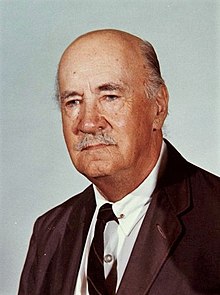
Back Igor Sikorsky Afrikaans إيغور سيكورسكي Arabic ايجور سيكورسكى ARZ İqor Sikorskiy Azerbaijani Ігар Іванавіч Сікорскі Byelorussian Ігар Сікорскі BE-X-OLD Игор Сикорски Bulgarian Ígor Sikorski Catalan Igor Sikorskij Czech Igor Sikorsky Danish
Igor Sikorsky | |
|---|---|
Игорь Сикорский | |
 Studio portrait, c. 1950 | |
| Born | Igor Ivanovich Sikorsky May 25, 1889 Kiev, Kiev Governorate, Russian Empire |
| Died | October 26, 1972 (aged 83) |
| Nationality | Russian-American[1][2][3] |
| Education | |
| Occupation | Aircraft designer |
| Known for | First successful mass-produced helicopter, the Sikorsky R-4 |
| Spouses |
|
| Children | 5 |
| Awards |
|
Igor Ivanovich Sikorsky (Russian: Игорь Иванович Сикорский, romanized: Igor Ivanovich Sikorsky, Ukrainian: Ігор Іванович Сікорський, romanized: Ihor Ivanovych Sikorskyi; 25 May 1889 – 26 October 1972)[4] was a Russian–American[1][2][3] aviation pioneer in both helicopters and fixed-wing aircraft. His first success came with the Sikorsky S-2, the second aircraft of his design and construction. His fifth airplane, the S-5, won him national recognition and F.A.I. pilot's license number 64.[5] His S-6-A received the highest award at the 1912 Moscow Aviation Exhibition, and in the fall of that year the aircraft won first prize for its young designer, builder and pilot in the military competition at Saint Petersburg.[6] In 1913, the Sikorsky-designed Russky Viyaz (S-21) became the first successful four-engine aircraft to take flight. He also designed and built the Ilya Muromets (S-22 – S-27) family of four-engine aircraft, an airliner which he redesigned to be the world's first four-engine bomber when World War I broke out.
After immigrating to the United States in 1919 because of the Russian Revolution, Sikorsky founded the Sikorsky Aircraft Corporation in 1923,[7] and developed the first of Pan American Airways' ocean-crossing flying boats in the 1930s, including the Sikorsky S-42 "Flying Clipper".
In 1939, Sikorsky designed and flew the Vought-Sikorsky VS-300,[8] the first viable American helicopter, which pioneered the rotor configuration used by most helicopters today.[9] Sikorsky modified the design into the Sikorsky R-4, which became the world's first mass-produced helicopter in 1942.
- ^ a b "Britannica Concise Encyclopedia" Archived April 4, 2023, at the Wayback Machine. Encyclopædia Britannica, Inc. 2006, p. 1751.
- ^ a b "Sergei Sikorsky: Reflecting on the 90th Anniversary of Sikorsky Aircraft" Archived July 19, 2015, at the Wayback Machine Quote: Some 90 years ago, on March 5, 1923, a Russian refugee named Igor Sikorsky organized a new company"
- ^ a b Jacobson, Lee (April 2013). "Igor Sikorsky Was a Reflection of His Heritage and Experiences in Life" (PDF). Sikorsky Archives News. Igor I. Sikorsky Historical Archives. Archived (PDF) from the original on January 21, 2022. Retrieved May 25, 2020.
My family is of Russian origin. My grandfather and other ancestors from the time of Peter the Great were Russian Orthodox priests. Consequently, the Russian nationality of the family must be considered as well established
- ^ Fortier, Rénald. "Igor Sikorsky: One Man, Three Careers." Archived October 16, 2013, at the Wayback Machine aviation.technomuses.ca, 1996. Retrieved: October 29, 2008.
- ^ "Sikorsky Archives | S-5". SikorskyArchives.com. Archived from the original on July 18, 2018. Retrieved July 28, 2018.
- ^ "History". SikorskyArchives.com. Part 2. Archived from the original on August 8, 2020. Retrieved April 27, 2020.
- ^ "About Sikorsky." Archived November 3, 2009, at the Wayback Machine Sikorsky Aircraft. Retrieved: December 11, 2008.
- ^ Spenser 1998, p. 25.
- ^ Woods 1979, p. 262.